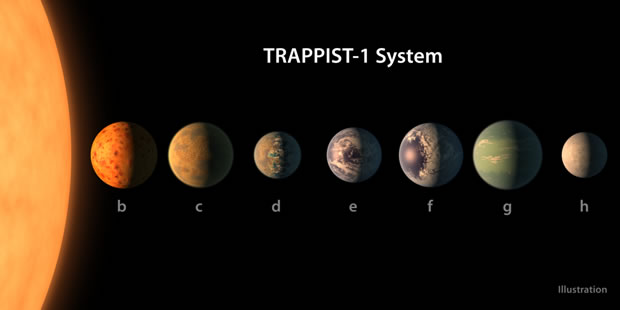This is no fairy tale - TRAPPIST-1 and the seven planets
Once upon a time there lived, Snow White and the seven dwarfs. But now, NASA may have discovered the real-life version - TRAPPIST-1 and the seven planets. It turns out that life may have been discovered 39 light years away, as this week NASA has made the announcement that seven new earth size planets have been discovered. Previously scientists have only found a tiny number of ‘exoplanets’ which are believed to have the qualities needed to support life.
It was the NASA Spitzer Space Telescope which revealed the first system of seven Earth-size planets around a single star. Three of these planets were seen firmly located in the habitable zone, around the parent star where a rocky planet is most likely to have water.
Setting a new record for greatest number of habitable-zone planets found around a single star outside our solar system, the discovery does show that all seven of the planets could contain water – suggest there maybe life as we know – under the right conditions, but the highest chance is of the three in the habitable zone.
Thomas Zurbuchen, Associate Administrator of the agency’s Science Mission Directorate in Washington, said: “This discovery could be a significant piece in the puzzle of finding habitable environments, places that are conducive to life.”
He continued: “Answering the question ‘are we alone’ is a top science priority and finding so many planets like these for the first time in the habitable zone is a remarkable step forward toward that goal.”
Although 39 light years (235 trillion miles) doesn’t sound it, the new system is quite close to planet Earth, in the constellation Aquarius, but technically as they are outside of our solar system they are scientifically referred to as exoplanets.
TRAPPIST-1 is what the new system has been named for The Transiting Planets and Planetesimals Small Telescope (TRAPPIST) in Chile.

Researchers used the TRAPPIST telescope back in 2016 and announced they had discovered three of the planets in the system, assisted then with other telescopes, including Spitzer it was confirmed that there was the existence of two of these and that five more had been discovered.
Based on their densities, all of the TRAPPIST-1 planets are likely to be rocky.
Michael Gillon, Lead Author of the paper and the Principal Investigator of the TRAPPIST exoplanet survey at the University of Liege, Belgium, commented: "The seven wonders of TRAPPIST-1 are the first Earth-size planets that have been found orbiting this kind of star.”
The star that the planets in TRAPPIST-1 orbit is significantly cooler than our sun, as it is classified an ultra-cool dwarf – is so cool that liquid water could survive on planets orbiting very close to it, closer than is possible on planets in our solar system.
In fact all the planets in the newly discovered system are closer to their sun, than Mercury is to our sun, also proving that’s the seven new plants are very close to each other.
For example if someone were to stand on one of the planet’s surface they could gaze up and potentially see geological features or clouds of neighbouring worlds, which would sometimes appear larger than the moon in Earth's sky.
Another discovery of the new system is that these planets may be tidally locked to their star, suggesting that one side of the planet is always facing the star – yes, meaning one side would be absolutely freezing! And that each side is designated as day or night.
This may mean that the weather patterns on the TRAPPIST-1 are completey unlike those that are on Earth, such as strong winds blowing from the day side to the night side, and extreme temperature changes.
Sean Carey, Manager of NASA's Spitzer Science Center at Caltech/IPAC in Pasadena, California, commented: "This is the most exciting result I have seen in the 14 years of Spitzer operations. Spitzer will follow up in the fall to further refine our understanding of these planets so that the James Webb Space Telescope can follow up. More observations of the system are sure to reveal more secrets.”
And they all lived happily ever after?










